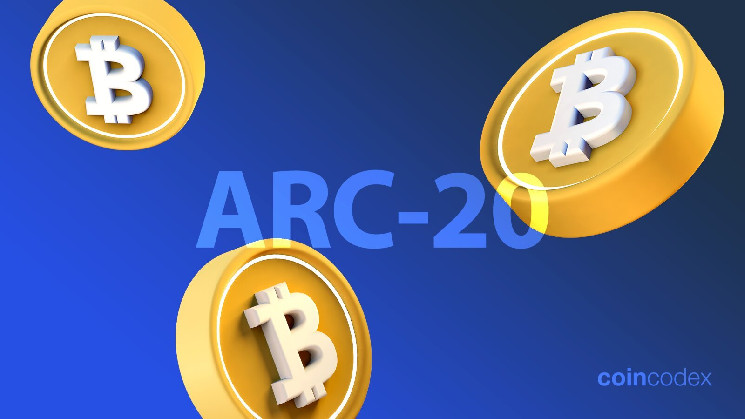ARC-20 is a token standard that allows the creation of fungible tokens that can be held and transferred on the Bitcoin blockchain. ARC-20 standard tokens are issued using the Atomicals protocol. In the ARC-20 standard, tokens are represented by satoshisthe original unit of the Bitcoin blockchain (1 BTC consists of 100 million satoshis).
ARC-20 is a fungible token standard for Bitcoin
The concept of fungible tokens was popularized in the cryptocurrency space by Ethereum, where they are typically issued using the ERC-20 standard. Certain ERC-20 tokens have reached massive market capitalizations – some of the largest fungible tokens on the market today include UNI, SHIB, LDO and of course stablecoins.
The ability to create fungible tokens is available on virtually every blockchain platform with general purpose smart contracts. For example, there are fungible tokens on Solana (SLP tokens), BNB Chain (BEP-20 tokens), Cardano (native tokens), and so on.
Although Bitcoin’s smart contract capabilities are much more limited, developers have come up with creative ways to represent different types of digital assets (fungible and non-fungible tokens) on the Bitcoin blockchain.
The ARC-20 token standard is powered by the Atomicals Protocol, a way to create both fungible and non-fungible tokens on Bitcoin. The Atomicals team calls the digital assets that can be created through the protocol “digital objects.”
Minting ARC-20 tokens
Anyone can create an ARC-20 token and control its offering, ticker and metadata (e.g. official website, social media links and an image). However, because each ARC-20 token is represented by 1 satoshi, there is actually a practical limit to the number of ARC-20 tokens someone can mint.
This differs from the ERC-20 standard, for example, where you can make the supply of a token as large as you want, at no additional cost, as you create it. For example, many meme coins issued on blockchains like Ethereum have a supply of hundreds of trillions of tokens.
The process of creating ARC-20 tokens and its implications for token supply are perhaps the most unique aspect of ARC-20 tokens compared to other fungible token standards in use today, so let’s break it down in a bit more detail to explain.
Decentralized ARC-20 token coining
The decentralized ARC-20 token coin mode allows the token creator to specify how many mints of the token are allowed, and how many tokens are issued in one coin. This in itself does not create tokens, but users who want the token can mint them.
Instant ARC-20 token coining
In instant coin mode, the user who creates the ARC-20 token creates an output that contains the total supply of the token. For example, if you want to create a token with a supply of 10 million using instant mint mode, you need to create an output of 10 million satoshis (0.1 BTC). The more tokens you want to earn, the more BTC you have to supply.
How do I use ARC-20 tokens?
To hold and transact with ARC-20 tokens, you will need a Bitcoin wallet that supports UTXO selection, also known as “coin checking.” Here are a few examples of such wallets:
- Sparrow
- Electricity
- Mycelium
- Blue wallet
- Ledger Live
ARC-20 vs BRC-20 – Atomicals and Ordinal Numbers Compared
ARC-20 tokens perform a similar function to BRC-20 tokens, which are also fungible tokens on the Bitcoin network, except they are issued via the Ordinals protocol.
Although Atomicals and Ordinals offer very similar utility, the two protocols differ in some areas. Notably, Ordinals should be used with Taproot addresses for all use cases. Atomicals require the use of Taproot addresses for creating and updating assets, but not for transferring them.
Fungible tokens are not supported in the base Ordinals protocol, while Atomicals implements them as the top-tier ARC-20 standard. The Atomicals protocol also supports two different types of fungible tokens.
Another difference is that Ordinals does not have a name service in the base protocol. Meanwhile, Atomicals has a naming service implemented through premium NFTs called Realms.
In summary, the Atomicals protocol offers a broader set of features than Ordinals, but the Ordinals protocol has seen more adoption so far. To be fair, the Ordinals protocol has benefited from a head start as it was launched in January 2023, while the Atomicals protocol was released in September 2023.
At the moment, the Ordinals protocol is a lot more popular than the Atomicals protocol, although Atomicals has gained some traction. In total, the Atomicals protocol transactions generated approximately 274 BTC in fees, while the Ordinals protocol transactions generated 4,050 BTC in fees.
If you’d like to see a comparison between Ordinals and Atomicals based on on-chain activity, you can check out this handy Dune Analytics dashboard that compares the two protocols.
it comes down to
ARC-20 tokens are fungible tokens issued on the Bitcoin blockchain using the Atomicals Protocol. When ARC-20 tokens are minted, each token is represented by a satoshi, the smallest unit of BTC.
In terms of functionality, ARC-20 tokens are quite similar to BRC-20 tokens, which are issued using the Ordinals protocol. Currently, the Ordinals protocol is more popular than the Atomicals protocol, but the Atomicals protocol offers some additional features that could help it gain more acceptance.
If you want to learn more about Bitcoin, check out our article explaining how Bitcoin wallet addresses work.

